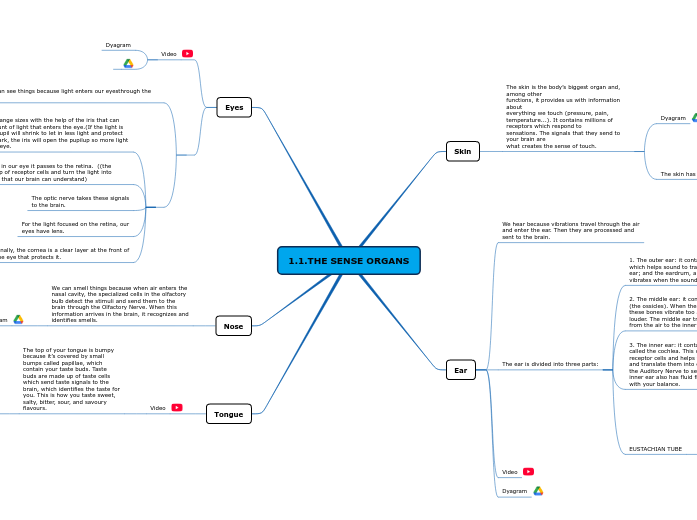1.1.THE SENSE ORGANS
Skin
The skin is the body’s biggest organ and, among other
functions, it provides us with information about
everything we touch (pressure, pain, temperature...). It contains millions of receptors which respond to
sensations. The signals that they send to your brain are
what creates the sense of touch.
Dyagram
The skin has three layers:
1. Epidermis: it is the outer layer, and it contains
specialized cells that receive information from the
outside.
2. Dermis: it is the middle layer, containing sweat glands.
3. Fat layer: it is the inner layer and keeps us warm.
Ear
We hear because vibrations travel through the air
and enter the ear. Then they are processed and
sent to the brain.
The ear is divided into three parts:
1. The outer ear: it contains the ear canal,
which helps sound to travel further inside our
ear; and the eardrum, a thin membrane that
vibrates when the sound hits it.
2. The middle ear: it contains three bones in it
(the ossicles). When the eardrum vibrates,
these bones vibrate too and make the sound
louder. The middle ear transfers the sounds
from the air to the inner ear.
3. The inner ear: it contains the hearing organ
called the cochlea. This organ contains the
receptor cells and helps to take the vibrations
and translate them into electrical signals for
the Auditory Nerve to send to the brain. The
inner ear also has fluid filled tubes that help
with your balance.
EUSTACHIAN TUBE
This tube runs between the ear and
the throat and it keeps the same
pressure on both sides of the eardrum.
Have you ever had trouble hearing on
an airplane? Try yawning or chewing
gum and pop! Your eustachian tube
will open and you'll be able to hear
normally again.
Video
Dyagram
Eyes
Video
Dyagram
We can see things because light enters our eyesthrough the pupil
The pupil can change sizes with the help of the iris that can control the amount of light that enters the eye.(If the light is too bright, the pupil will shrink to let in less light and protect
the eye. If it's dark, the iris will open the pupilup so more light can get into the eye.
Once the light is in our eye it passes to the retina. ((the retina is made up of receptor cells and turn the light into electrical signals that our brain can understand)
The optic nerve takes these signals
to the brain.
For the light focused on the retina, our
eyes have lens.
Finally, the cornea is a clear layer at the front of
the eye that protects it.
Nose
We can smell things because when air enters the
nasal cavity, the specialized cells in the olfactory
bulb detect the stimuli and send them to the
brain through the Olfactory Nerve. When this
information arrives in the brain, it recognizes and
identifies smells.
Dyagram
Tongue
Video
The top of your tongue is bumpy
because it’s covered by small
bumps called papillae, which
contain your taste buds. Taste
buds are made up of taste cells
which send taste signals to the
brain, which identifies the taste for
you. This is how you taste sweet,
salty, bitter, sour, and savoury
flavours.
dyagram
